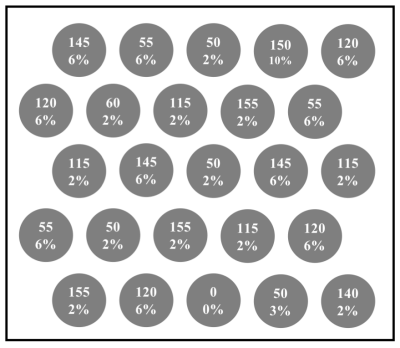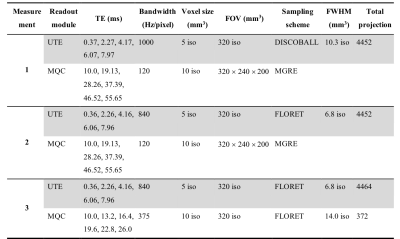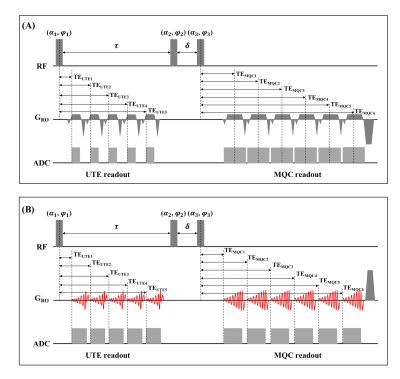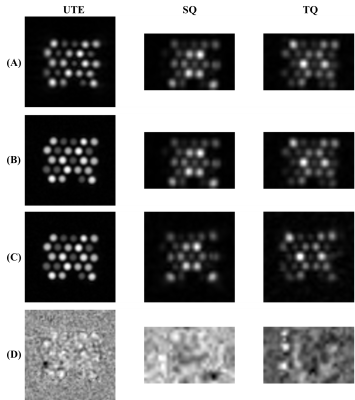1804
Triple-quantum-filtered Sodium MRI at 7T: Optimization of the Enhanced SISTINA Sequence Using FLORET k-space Trajectories1Institute of Neuroscience and Medicine 4, INM-4, Forschungszentrum Jülich, Germany, 2Department of Neurology, RWTH Aachen University, Aachen, Germany, 3Department of Biomedical Engineering, The University of Melbourne, Parkville, Australia, 4Institute of Neuroscience and Medicine 11, INM-11, JARA, Forschungszentrum Jülich, Germany, 5JARA - BRAIN - Translational Medicine, Aachen, Germany
Synopsis
It has been reported that enhanced SISTINA, one of the triple-quantum-filtered sodium MRI techniques, can selectively measure the distribution of restricted sodium, which may be sensitive to metabolic cellular dysfunction. In this work, the enhanced SISTINA sequence was optimized for 7T using FLORET, which has high k-space filling efficiency and good potential for undersampling. The optimized enhanced SISTINA sequence greatly improves the UTE image quality, while maintaining the multiple-quantum-filtered image performance and introducing incoherent randomness to the raw data. We believe the optimized enhanced SISTINA has promising potential for clinical applications with faster scans using compressed-sensing reconstruction in future.
Introduction
Sodium MRI can measure the distribution of sodium in the human body noninvasively, thus providing valuable metabolic information for scientific research and clinical practice1. Imaging intracellular sodium is particularly useful because it reflects, for example, the operational status of the sodium-potassium pump, while the extracellular sodium concentration remains constant due to the perfusion of the tissue. It is assumed that single-quantum (SQ) coherences evolve both in restricted (mainly intracellular) and non-restricted (mainly extracellular) environments, while triple-quantum (TQ) coherences develop mostly in a restricted, intracellular environment2. Triple-quantum-filtered (TQF) sodium MRI can produce TQ-weighted images, thus allowing for compartmental differentiation between intra- and extracellular sodium through the appropriate combination of coherences3. Enhanced SISTINA is a delicate TQF sequence with two separate readouts4: ultrashort echo time (UTE) readouts after the first RF pulse, and multiple-quantum coherence (MQC) readouts following the third RF pulse, enabling the simultaneous acquisition of SQ and TQ coherences. However, the clinical application of TQF sodium MRI is hampered due to its relatively low image quality and associated long acquisition time. The goal of the present work is to optimize enhanced SISTINA by employing FLORET k-space trajectories5, which have attractive properties of high k-space sampling efficiency and the potential for incoherent undersampling. The latter property is desirable for compressed sensing (CS) reconstruction to accelerate data acquisition.Methods
Agarose phantoms (see Fig.1) mimicking restricted and less-restricted environments in the human body were scanned in a Siemens Terra 7T MRI scanner (Siemens Healthcare, Erlangen, Germany) with a transmit/receive dual-tuned 1H/23Na birdcage coil (Rapid Biomedical, Germany). Three measurements were conducted to assess the performance of enhanced SISTINA with different implementations of k-space trajectories (see Table 1). Conventional enhanced SISTINA (see Fig.2A) with 3D-radial DISCOBALL (see Fig.3A) UTE readouts and multi-echo gradient echo (MGRE) MQC readouts was performed in the first measurement, and in the subsequent measurement DISCOBALL was replaced with 3D-spiral FLORET. In the last measurement, both the DISCOBALL and MGRE were replaced with FLORET (see Fig.2B). The FLORET k-space trajectories of UTE and MQC readouts are shown in Fig.3B and Fig.3C, respectively. Non-Cartesian raw data were reconstructed using Jeff Fessler’s Michigan Image Reconstruction Toolbox (MIRT). B0 mapping was performed with a dual-echo 3D spoiled GRE sequence, and flip-angle maps were obtained using the phase-sensitive B1 mapping sequence with a gradient echo readout.Results
Fig.4 shows the first-echo UTE, SQ, and TQ images after B0 and B1 correction obtained from three measurements. In the first measurement with conventional enhanced SISTINA (see Fig.4A), the total sodium-weighted UTE image shows higher signal intensity in phantoms with higher sodium concentration (e.g. 145 mmol/L) regardless of the agarose percentage. SQ images are weighted towards less-restricted sodium because restricted sodium is more prone to evolve from SQ into TQ coherences through three RF pulses' excitation2. In the SQ image shown in Fig.4A, the 2% agarose phantoms with high sodium concentration have significantly higher signal-to-noise ratio (SNR) than 6% and 10% agarose phantoms, as expected. Conversely, in the TQ image weighted towards restricted sodium, 6% agarose phantoms with a sodium concentration of 145 mmol/L present high SNR, whereas the signal from 2% and 3% phantoms is well-suppressed. The SNR of the 10% agarose phantom in the TQ image may be affected by the fast T2* relaxation, but nevertheless, it is still higher than that in the SQ image. In the second measurement (see Fig.4B), the replacement of DISCOBALL UTE readouts (full width at half maximum (FWHM) of point spread function = 10.3mm) with FLORET (FWHM = 6.8mm) effectively reduces the image blurring and increases the SNR of the UTE image (see Fig.4B left) without introducing significant difference to the SQ and TQ images (see Fig.4D middle and right). In the last measurement (see Fig.4C), the substitution of FLORET for MGRE MQC readouts has little effect on the UTE images in light of the noise-like UTE image difference between the second and third measurements (see Fig.4D left). Furthermore, SQ and TQ images obtained with FLORET MQC readouts are in good agreement with those produced by MGRE MQC readouts, indicating that the MQC acquisition with FLORET readouts does not suffer from the non-Cartesian data acquisition and image reconstruction.Conclusion
The employment of FLORET as a replacement for DISCOBALL UTE readouts of the conventional enhanced SISTINA sequence can significantly improve the UTE image quality without affecting the MQC data acquisition. In addition, MQC data acquisition with FLORET readouts can produce satisfactory SQ and TQ images while maintaining the performance of UTE images. Moreover, it introduces an incoherent random pattern to the raw data, which is essential for CS reconstruction. The ultra-high field system can offer better image resolution for TQF sodium MRI and especially for TQ-weighted images. We believe that the optimized enhanced SISTINA has great potential for the simultaneous acquisition of higher-quality UTE, SQ, and TQ images in an accelerated scan at 7T by recruiting CS reconstruction, therefore promoting scientific research and clinical application in the future.Acknowledgements
Qingping Chen is in part funded by Jülich-University of Melbourne Postgraduate Academy (JUMPA).
The authors express their sincere gratitude to Dr. Zhentao Zuo for his kind support in implementing FLORET.
References
1. Shah NJ, Worthoff WA, Langen KJ. Imaging of sodium in the brain: a brief review. NMR Biomed. 2016;29(2):162-174.
2. Rooney WD, Springer CS Jr. A comprehensive approach to the analysis and interpretation of the resonances of spins 3/2 from living systems. NMR Biomed. 1991;4(5):209-226.
3. Fiege DP, Romanzetti S, Tse DH, et al. B0 insensitive multiple-quantum resolved sodium imaging using a phase-rotation scheme. J Magn Reson. 2013;228:32-36.
4. Worthoff WA, Shymanskaya A, Shah NJ. Relaxometry and quantification in simultaneously acquired single and triple quantum filtered sodium MRI. Magn Reson Med. 2019;81(1):303-315.
5. Pipe JG, Zwart NR, Aboussouan EA, et al. A new design and rationale for 3D orthogonally oversampled k-space trajectories. Magn Reson Med. 2011;66(5):1303-1311.
Figures




